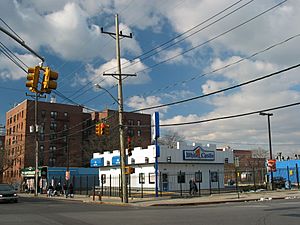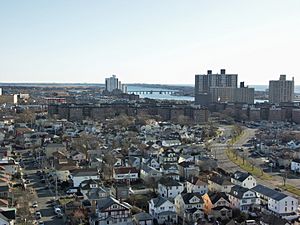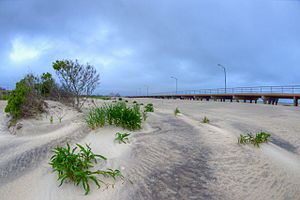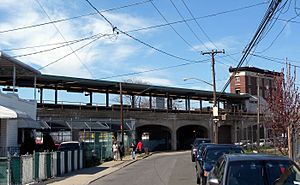Far Rockaway facts for kids
Quick facts for kids
Far Rockaway
|
|
|---|---|
|
Neighborhood of Queens
|
|

Far Rockaway in 2005
|
|
| Country | |
| State | |
| City | New York City |
| County/Borough | Queens |
| Community District | Queens 14 |
| Named for | Place name of the Native American Lenape. |
| Population
(2010)
|
|
| • Total | 50,058 |
| Ethnicity | |
| • Non-Hispanic White | 25.5% |
| • Black or African-American | 44.7% |
| • Hispanic or Latino of any race | 24.7% |
| • Asian | 1.9% |
| • Other | 1.4% |
| • Two or more races | 1.7% |
| Economics | |
| • Median income | ,820 |
| Time zone | UTC−5 (EST) |
| • Summer (DST) | UTC−4 (EDT) |
| ZIP Code |
11691, 11693
|
| Area codes | 718, 347, 929, and 917 |
Far Rockaway is a neighborhood on the eastern part of the Rockaway peninsula in the New York City borough of Queens. It is the easternmost section of the Rockaways. The neighborhood extends from Beach 32nd Street east to the Nassau County line. Its southern boundary is the Atlantic Ocean; it is one of the neighborhoods along Rockaway Beach.
Far Rockaway is located in Queens Community District 14 and its ZIP Codes are 11691 and 11693. It is patrolled by the New York City Police Department's 101st Precinct.
Contents
History
Precolonial and colonial era
The indigenous inhabitants of the Rockaways were the Canarsie Indians, a band of Mohegan, whose name was associated with the geography. By 1639, the Mohegan tribe sold most of the Rockaways to the Dutch West India Company. In 1664, the English defeated the Dutch colony and took over their lands in present-day New York. In 1685, the band chief, Tackapoucha, and the English governor of the province agreed to sell the Rockaways to a Captain Palmer for 31 pounds sterling.
The Rockaway Peninsula was originally designated as part of the Town of Hempstead, then a part of Queens County. Palmer and the Town of Hempstead disputed over who owned Rockaway, so in 1687 he sold the land to Richard Cornell, an iron master from Flushing. Cornell and his family lived on a homestead on what is now Central Avenue, near the shore of the Atlantic Ocean. At his death, Cornell was buried in a small family cemetery, Cornell Cemetery.
19th century
In the late 19th century, the Rockaway Association wanted to build a hotel on the Rockaway Peninsula, as it was increasingly popular as a summer destination. The association, consisting of many wealthy members who had homes in the area, bought most of Cornell's old homestead property. They developed the Marine Pavilion on that site, which attracted such guests as Henry Wadsworth Longfellow, Washington Irving, and the Vanderbilt family. The Rockaway Association also built the Rockaway Turnpike. The Marine Hotel burned to the ground in 1864, but more hotels and private residences were built in the area.
In the 19th century, people traveled to the Rockaways by horse-drawn carriages or on horseback. A ferry powered by steam sailed from Lower Manhattan to Brooklyn. By the 1880s, the Long Island Rail Road's Rockaway Beach Branch was built to serve Far Rockaway station. The steam railroad went to Long Island City and Flatbush Terminal (now Atlantic Terminal). When it opened in the 1880s, this connection stimulated population growth on the Rockaway Peninsula. Benjamin Mott gave the LIRR 7 acres (2.8 ha) of land for a railroad depot. Land values increased and businesses in the area grew, and by 1888, Far Rockaway was a relatively large village. It incorporated as a village on September 19 of that year.
20th century to present
In 1898, the area was incorporated into the City of Greater New York and became part of Queens. The neighborhoods of Far Rockaway, Hammels, and Arverne in Queens tried to secede from the city several times. In 1915 and 1917, a bill approving secession passed in the legislature but was vetoed by the New York City mayor John Purroy Mitchel. The area saw economic decline in World War I and again during the Great Depression. New apartment complexes were built in the neighborhood following World War II, but the construction of public housing and medical institutions again caused the reputation of Far Rockaway to decline in the 1960s.
In September 2017, the New York City Council voted to rezone 23 blocks in the center of Far Rockaway, after the New York City Planning Commission approved the rezoning. The rezoning would allow as many as 3,100 residences to be built in the neighborhood, as well as community spaces and retail. Following the rezoning, city officials approved 670 affordable apartments within the area in 2018.
Demographics
Based on data from the 2010 United States Census, the population of Far Rockaway was 50,058, a change of 1,714 (3.4%) from the 48,344 counted in 2000. Covering an area of 1,251 acres (506 ha), the neighborhood had a population density of 40 inhabitants per acre (26,000/sq mi; 9,900/km2).
The racial makeup of the neighborhood was 25.5% (12,778) White, 44.7% (22,400) African American, 0.3% (175) Native American, 1.9% (931) Asian, 0.1% (44) Pacific Islander, 1% (504) from other races, and 1.7% (860) from two or more races. Hispanic or Latino of any race were 24.7% (12,366) of the population.
Far Rockaway is a diverse neighborhood with many immigrants from Jamaica, Guyana, and Guatemala, as well as Russia and Ukraine. It also is home to a significant number of Orthodox Jews.
Points of interest
Bungalows
The Far Rockaway Beach Bungalow Historic District recognizes an area with a distinct character. This and individual properties, such as the Russell Sage Memorial Church, Trinity Chapel, and United States Post Office are listed on the National Register of Historic Places.
With its nearby beach, Far Rockaway attracted tourists and vacationers from the other boroughs. Bungalows were the homes of choice for many residents who lived in Far Rockaway. The railroad abandoned the Rockaway Beach Branch in 1950 because of the shift of many people to driving private cars. In addition, this destination had to compete with the many others that people were visiting by car and air travel, which created access to even more distant destinations and heightened competition for travel dollars.
As the neighborhood's heyday as a resort community declined in the 1950s, the city built substantial numbers of public housing developments to try to replace substandard housing after World War II. Bungalows and other residential housing were converted to year-round use for low-income residents. Some bungalows were used as public housing. .....
In September 1984, residents founded the Beachside Bungalow Preservation Association to "improve the quality of the Far Rockaway community through preservation, education, and cultural programs". The organization donated a collection of materials highlighting its history, correspondence, and activities to the Queens Library Archives in 2008.
Parks
Fire safety
Far Rockaway is served by the New York City Fire Department (FDNY)'s Engine Cos. 264 and 328/Ladder Co. 134, located at 16-15 Central Avenue.
Post office and ZIP Code
Far Rockaway is covered by ZIP Code 11691. The United States Post Office operates the Far Rockaway Station at 18-36 Mott Avenue.
Education
Schools
Public schools
The neighborhood, like all of New York City, is served by the New York City Department of Education. Far Rockaway residents are zoned to several different elementary schools:
- P.S. 43
- P.S. 104 (The Bayswater School) (Kindergarten–6th grade)
- P.S. 105 (The Bay School)
- P.S. 106
- P.S. 197 (The Ocean School)
- P.S. 215 (W.A.V.E Prep)
- P.S. 253
Far Rockaway residents are zoned to M.S. 53 Brian Piccolo.
All New York City residents who wish to attend a public high school must apply to high schools. Far Rockaway High School was located in Far Rockaway, but was shut down in 2011 as a stand-alone institution. During the administration of Mayor Michael Bloomberg in 2011, many large, underperforming, older traditional high schools were closed in the city. The 1929 building was renovated to operate as the Far Rockaway Educational Campus, home to a number of smaller, specialized academies that share the building. They can provide more individualized attention to their students. The former Beach Channel High School was similarly closed in 2014 and repurposed to house several smaller, specialized academies; it is in Rockaway Park, near Far Rockaway, and draws some of its students from Far Rockaway.
Library
Queens Public Library operates the Far Rockaway branch at 1637 Central Avenue. The library replaced another one that was also located on Central Avenue. In 2013, New York magazine reported that the city planned to construct a public library in the neighborhood, to be designed by the internationally known architectural firm Snøhetta. Construction started in November 2018, and the new library opened in July 2024 at a cost of $39 million. The current building is 18,000 square feet (1,700 m2) across two stories, with a glass facade and a blue roof that collects rainwater. The building's facade includes the artwork Style Writing by José Parlá, while the second floor has the artwork Feynman Code by Pablo Helguera.
Jewish institutions
During the early and mid-20th century, many Jewish immigrants and their working-class descendants settled in Far Rockaway, sometimes first as summer visitors. They founded numerous synagogues and private schools, including those devoted to all-boys or all-girls institutions for educating Orthodox children. Following World War II, as residential housing was developed in Nassau and later Suffolk counties, many Jewish families left the Rockaways for newer housing. According to The New York Times, Far Rockaway had "flourished in the 1940s but withered...1960s" until "a few Jewish families...started the Hebrew Free Loan Society for new home buyers."
Synagogues include Congregation Kneseth Israel in Far Rockaway (The White Shul), which was founded in 1922. Schools include Sh'or Yoshuv Institute of Jewish Studies/Sh'or Yoshuv Yeshiva, Yeshiva Darchei Torah and the Yeshiva of Far Rockaway.
Other synagogues (past and present):
- Agudath Israel of Long Island
- Agudath Israel of West Lawrence
- Bayswater Jewish Center
- Young Israel of Far Rockaway
- Young Israel of Bayswater
Other schools (past and present):
- Bnois Bais Yaakov
- Siach Yitzchok Elementary School for Boys
- Torah Academy for Girls
- The Hebrew Institute of Long Island
- Yeshiva Ateres Shimon
- Mechon Sara
Transportation
Far Rockaway is served by the following transportation services:
- The New York City Subway's IND Rockaway Line (A train), which has a terminal at Mott Avenue.
- The Far Rockaway terminal station for the Long Island Rail Road's Far Rockaway Branch. The branch had been part of a loop with service along the existing route, continuing through the Rockaway Peninsula and crossing on a trestle across Jamaica Bay through Queens, where it reconnected with other branches. Frequent fires and maintenance problems led the LIRR to abandon the Queens portion of the route. The city acquired this to develop the IND Rockaway Line.
- MTA Regional Bus Operations: Q22, Q113, Q114, QM17
- Nassau Inter-County Express: n31, n31x, n32, n33. Unlike other NICE routes in Queens, these buses operate open-door in Far Rockaway, meaning customers can ride these buses wholly within the neighborhood without going to Nassau County.
Notable people
- Nisson Alpert (1927–1986), rabbi who was Rosh Yeshiva at the Rabbi Isaac Elchanan Theological Seminary
- Khaleel Anderson (born 1996), politician who has represented the 31st district of the New York State Assembly since 2020
- Richard Bey (born 1951), talk show host; went to Far Rockaway High School
- Baruch Samuel Blumberg (1925–2011), winner of 1976 Nobel Prize in Medicine; graduated from Far Rockaway High School in 1942
- Avrohom Blumenkrantz (1944–2007), Orthodox rabbi who was a widely consulted authority on the laws of Passover kashrut
- Albert J. Brackley (1874–1937), politician who served in the New York State Assembly
- Steven Brill (born 1950), journalist and founder of Court TV
- Joyce Brothers (1927–2013), family psychologist and advice columnist; grew up in Far Rockaway
- Joseph Cassidy (c. 1866–1920), political boss who served as borough president of Queens
- Chinx (1983–2015), rapper, grew up in both the Redfern Houses and Edgemere Houses (the latter are now known as Ocean Bay Apartments)
- Cormega (born Cory McKay, 1970), rapper, lived in Far Rockaway as a youth
- Mac DeMarco (born 1990), Canadian songwriter and musician; has a house in Far Rockaway, where he recorded his album Another One
- Father MC (born 1967), recording artist with Uptown Records
- Folorunso Fatukasi (born 1995), defensive end for the New York Jets
- Olakunle Fatukasi (born 1999), linebacker for Rutgers
- Joan Feynman (1927–2020), astrophysicist and NASA Exceptional Achievement Medal recipient
- Richard Feynman (1918–1988), physicist and Nobel Prize winner; grew up in Far Rockaway and graduated from Far Rockaway High School.
- Marcus Gaither (1961–2020), professional basketball player in France and Israel, who played the guard position and led the Israel Basketball Premier League in scoring in 1989–90
- Mary Gordon (born 1949), writer of novels, memoirs, and literary criticism, and professor at Barnard College; born in Far Rockaway and lived there for several years
- Margo Guryan (1937–2021), singer-songwriter, musician and lyricist who is remembered for her 1968 album "Take A Picture"
- Steven Handel (born 1945), educator and restoration ecologist
- Zander Hollander (1923–2014), sportswriter, journalist, editor and archivist
- Carl Icahn (born 1936), businessman and philanthropist; grew up in Far Rockaway and went to Far Rockaway High School
- Al Jaffee (1921–2023), cartoonist best known for his work in the satirical magazine Mad, including his trademark feature, the Mad Fold-in
- Nancy Lieberman (born 1958), women's basketball pioneer; grew up in Far Rockaway
- Deborah Lipstadt (born 1947), historian
- Bernard Madoff (1938–2021), former American stockbroker, investment advisor, and financier who was convicted of fraud; went to Far Rockaway High School, where he met his wife, Ruth Alpern
- Steve Madden (born 1958), shoe designer and former CEO of Steve Madden Ltd; born in Far Rockaway
- Cliff Mass (born 1952/53), atmospheric sciences professor and weather and climate blogger; born in Far Rockaway
- Alice Nielsen (1872–1943), Broadway performer and operatic soprano; owned a house in Far Rockaway in the 1920s
- Barbara Novak (born 1929), art historian, novelist, National Book Award for Nonfiction finalist
- Phil Ochs (1940–1976), folk-protest singer; resided here for a period during childhood and died at his sister's home here
- Ryan Pearson (born 1990), professional basketball player
- Kelly Price (born 1973), nine-time Grammy nominated R&B and gospel singer and songwriter grew up in the Edgemere Projects
- Rammellzee (1960–2010), rap pioneer; born and died in Far Rockaway
- Kenneth Alan Ribet (born 1948), mathematician
- Burton Richter (1931–2018), winner of 1976 Nobel Prize in Physics; graduated from Far Rockaway High School in 1948
- Gary Schwartz (born 1940), art historian
- MC Serch (born 1967 as Michael Berrin), former member of the hip hop group 3rd Bass
- Raymond Smullyan (1919–2017), mathematician; grew up in Far Rockaway
- Herbert Sturhahn (1902–1979), football player elected to the College Football Hall of Fame; born in Far Rockaway
- Conrad Thibault (1903–1987), baritone vocalist who frequently appeared on radio, recordings, and concert tours





